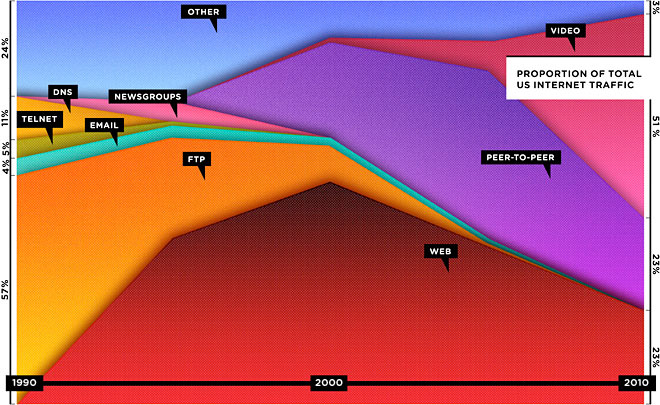Somewhere on a dusty shelf or storage box, I have this old issue of Wire Volume One two containing the strident prediction: “Tired: lynx, Wired: Mosaic”. Lynx is/was a text-only terminal app used for navigating a relatively obscure hypertext protocol, fancifully called the World Wide Web. NCSA Mosaic, was the first popular graphical web browser, which very soon became a little app you old-timers may recall called “Netscape”. The rest, they are now saying, is history.
If you’ve followed this blog for years, you know I love to track dead media. I’ve followed the death of print, of video stores of bloggin and many more. Wired themselves have even quoted me on the subject. Well the good folks at wired (ironically the magazine that most embodied the birth of the web) have really done it this time. This time, they’ve declared the whole web a dead medium.
You’ve spent the day on the Internet — but not on the Web. And you are not alone.
This is not a trivial distinction. Over the past few years, one of the most important shifts in the digital world has been the move from the wide-open Web to semiclosed platforms that use the Internet for transport but not the browser for display. It’s driven primarily by the rise of the iPhone model of mobile computing, and it’s a world Google can’t crawl, one where HTML doesn’t rule. And it’s the world that consumers are increasingly choosing, not because they’re rejecting the idea of the Web but because these dedicated platforms often just work better or fit better into their lives (the screen comes to them, they don’t have to go to the screen). The fact that it’s easier for companies to make money on these platforms only cements the trend. Producers and consumers agree: The Web is not the culmination of the digital revolution.
The venerable Marshall McLuhan teaches us that all media has a natural lifespan. This is because new media inevitably makes room for itself by obsolescing, replacing or just crowding out old media. While some may last much longer than others, all media eventually die. For better or worse, the indomitable human spirit is just too good at creating new things. As the pace of innovation has so quickened in recent decades and centuries, the average useful lifespan for even our most clever creations, seems to get shorter and shorter. For those of us fascinated by dead media, the graphic above provides a beautiful visualization of how new media propagate like wave functions. The grow, they crest and eventually break. Each media seem to expand and taper off to their own idiosyncratic schedule. At least until new media inevitably cascade over top. The pixels don’t lie.
Sorry kids, clearly the web is dead. Long live the web.
LINK: The Web Is Dead. Long Live the Internet [wired.com]
UPDATE: TVO’s Jesse Brown posted a hilarious video rebuttal “Wired is Dead“. Of course, Jesse should know better. Even if only half-true, the other half of the fun of declaring anything dead, is purely for the trolling. Good job Wired.


I love how your blog links to a dead-tree magazine's blog that links back to your blog about how blogging is dead.
I hate to be a pedantic jackass about something that self-selects me as a nerd-troll, but Wired did not mention Mosaic until 2.01. I remember reading http://www.wired.com/wired/archive/2.01/net_surf.html like it was yesterday, even the room I read it in. That issue was also my first exposure to Douglas Coupland, through the Microserfs short story that ended up being expanded into a book.
Tired/Wired from 1.01 is actually kind of surreal, viewed in 2010:
Tired: Nintendo, REM
Wired: 3DO, The Jayhawks
http://www.wired.com/wired/archive/1.01/tiredwired.html
That's awesome, thanks for checking. I thought it was sometime in their first volume but I did remember that the first wired issues predated the graphical web. I seem to remember is was Wired, boingboing and Mondo2000 the early bibles of stylish geekery.
It's fun to go back and look at the old ads … get blown away! by the speed of new 28.8 modems or 3x CDROM drives… etc.
Actually, that graph seems to be misleading is I'm reading it correctly.
Notice that DNS and Web are down relative to video and peer-to-peer. If the values are proportion of traffic, then even if Web (http) usage was increasing, the volume of a movie or p2p file transfer (also most likely a movie) would dilute the figures so that it looked like “the web” was dead.
In fact all its really showing is that the proportion of data attributed to video is rising… which we know to be true as more and more people get their content via streams (Netflix, iTunes, Youtube, etc). It shows that more data is video, and possibly the web has become more efficient… in no way does it actually way that the web is dead.
I am very surprised that Wired would make this kind of mistake, let alone other pass it along.